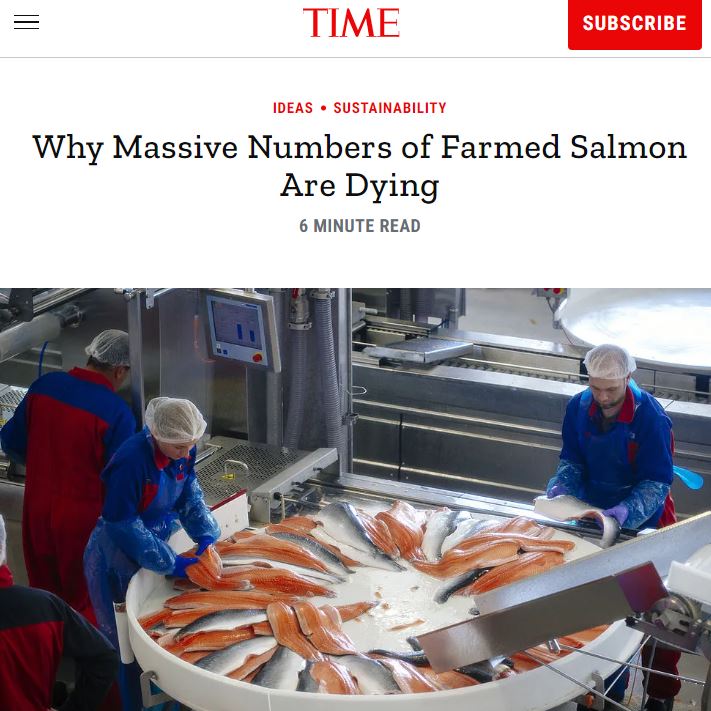 Heimurinn er að vakna og átta sig á því hversu hrikaleg meðferð sjókvíaeldisfyrirtækjanna er á eldislaxinum. Í engum öðrum búskap, þar sem dýr eru alin til manneldis, drepst jafn hátt hlutfall eldisdýra vegna aðstæðna, sjúkdóma og innbyggðra veikleika og í sjókvíaeldi á laxi.
Heimurinn er að vakna og átta sig á því hversu hrikaleg meðferð sjókvíaeldisfyrirtækjanna er á eldislaxinum. Í engum öðrum búskap, þar sem dýr eru alin til manneldis, drepst jafn hátt hlutfall eldisdýra vegna aðstæðna, sjúkdóma og innbyggðra veikleika og í sjókvíaeldi á laxi.
Um þetta má lesa víða í erlendum fjölmiðlum þessa dagana, meðal annars í meðfylgjandi grein bandaríska fjölmiðilsins Time.
Því miður er ástandið í sjókvíunum við Ísland verst af öllum þeim löndum sem stunda þennan grimmdarlega iðnað. Í fyrra drápust um 23 prósent af eldislaxi sem var í sjókvíum við landið.
Hver kynslóð af eldislaxi er að jafnaði um tvö ári í sjó. Þegar kemur að slátrun á þessum fiski má reikna með að um 40 prósent af eldislaxinum sem settur var í kvíarnar hafi drepist vegna vetrarsára, lúsasmits eða hjartasjúkdóma sem eldislaxar þjást svo til allir af vegna „kynbóta“ til að auka vaxtarhraða þeirra og þyngd.
Sjókvíaeldi á laxi er óboðleg aðferð við matvælaframleiðslu.
Í umfjöllun Time er fjallað um gríðarlegan laxadauða og nauðsyn þess að koma fiskeldinu á land :
A new study determined that 865 million farmed salmon have died in mass die-offs in the last decade. The scientists blame the deaths on several factors, from ocean warming caused by climate change to the aquaculture industry’s overuse of antibiotics and pesticides and its aggressive attempts to increase production. Beyond the staggering number of dead fish, the findings raise questions about the future of growing salmon in cages on the ocean—and aquaculture in general.
…
The peer-reviewed paper published this month in Nature was the first to analyze global data on these sudden die-offs. The scientists found that these events are increasingly common and killing more fish. The data came from the four largest salmon-producing countries, Norway, Chile, the United Kingdom, and Canada, as well as two smaller producers, Australia and New Zealand.
Among the common causes were lax government regulation, competition among companies to meet rising demand, and warming waters caused by the climate crisis…
Ocean temperatures show no sign of cooling. The National Oceanic and Atmospheric Administration said the average temperature of the ocean’s surface in 2023 was the highest since record keeping began in 1850—and 2.21 degrees F above the average for the 20th century. It is a trend with potentially catastrophic consequences, not just for farmed salmon but other marine species and the planet’s ability to avoid extreme weather events.
Salmon are cold-water fish. Warm water contains less oxygen, making it harder for salmon to breathe. Marine biologists have tracked both Atlantic and Pacific salmon migrating to the Arctic in search of a more hospitable environment.
Farmed salmon, however, are trapped in cages and cannot make the journey toward colder water. Last year, when a record 17.4 million farmed salmon died in Scotland, processors blamed warming water. The deaths of 100,000 salmon at two farms off the coast of Maine were attributed to low oxygen in the water, likely a result of rising temperatures. At least 2.6 million salmon died at 10 farms along the coast of Newfoundland in eastern Canada in late summer of 2019 during a prolonged spell of warm water. An inquiry into the die-off concluded that the salmon were already under stress from chemical treatments for parasites and suffocated after swimming to the bottom of the pens in search of cooler water.
Warming waters also allow parasites and viruses to thrive inside the cages, requiring farms to use more chemicals to try to stop outbreaks that can wipe out entire farms. Rising temperatures also contribute to algal blooms, which threaten salmon by further depleting oxygen levels.
…
Dr. Charles Mather, a professor at Memorial University in Newfoundland and a co-author of the Nature paper, told us that the highly profitable industry has absorbed mass mortalities for years and that these events won’t be what forces salmon farms out of the water. “I would look to Washington State to see how to get nets out of the water,” he said in an email interview.
Washington State banned non-native fish farms from its waters after the collapse of a salmon farm in Puget Sound sent 250,000 alien Atlantic salmon into the home waters of Pacific salmon. A state investigation concluded the collapse was caused by negligence, not climate change. But public outrage was so strong that elected officials enacted the ban within weeks.
Similar attempts to remove or restrict salmon farms in Canada, Scotland, Norway, Chile, and Australia have struggled. But opponents of ocean-based salmon farming hope that the new data on die-offs will buttress their case with consumers and producers that salmon farming on the ocean is unsustainable for the fish and the marine ecosystem.
